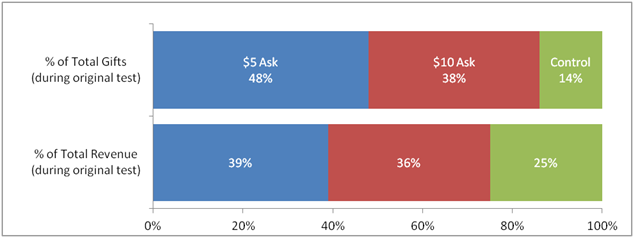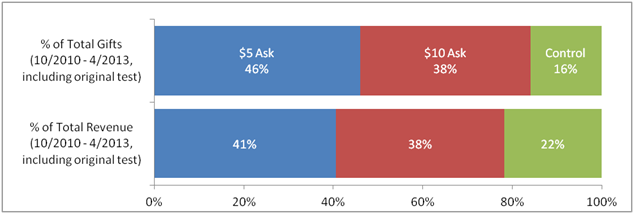In the grand tradition of 2 Fast 2 Furious, Dumb & Dumberer, and Police Academy 7: Mission to Moscow, we present the sequel to the classic blockbuster “Do $5 Asks Really Work?”
Here’s where we left our heroes: An analysis of tests run by 10 clients showed that a low-dollar ask to non-donors helped most organizations bring in more revenue in the campaign where the test was run.
But we really wanted to know how these low-dollar donors perform in the long term. So we took a perilous trip deep into the jungles of one client’s data to find out.
In September 2010, AARP ran a low-dollar ask test to non-donors throughout a multi-message email campaign using three equally-sized segments: a control with no specific donation amount ask in the email copy, a test with a $5 ask in the email copy, and a test with a $10 ask in the email copy.
Back in 2010, the low-dollar asks beat the control by a wide margin. Here’s what the data from the initial test looked like:

How have these low-dollar donors performed since then? The $5 ask segment still wins! Here’s a look at the donations by segment, combining the initial campaign revenue from 2010 with everything these donors have given online since then:

As you can see, when we combined these donors’ revenue from the initial campaign with their subsequent giving, the $5 ask donors have definitely brought in more online revenue for AARP than the other two segments. (Even when we took out the revenue from the initial test and JUST looked at subsequent giving, the $5 ask segment generated the most revenue. It looks kinda like the two charts above, so we’ll spare you the third chart.)
So what happened? Basically, the original test yielded more donors from the low-dollar segments, and having a bigger cohort of donors meant more revenue down the line, regardless of the fact that their initial average gift was lower.
But it’s not all roses. Since the original test, the percentage of $5 and $10 donors who gave again was about half of what AARP saw for donors who gave more than $10. That means you shouldn’t expect these low-dollar donors to suddenly transform into the same kind of donors you’re used to seeing. But this isn’t necessarily evidence that the lower dollar ask is reducing donor retention — what seems more likely to us is that the low-dollar ask is converting people who never would have given otherwise — and these people are also less likely to give again.
Bottom line: the $5 ask got more donors in the door. Those donors weren’t as loyal as those who gave bigger gifts, but because there were more of them, they ended up yielding more income in the long run.
We’re not saying every nonprofit should switch to $5 asks for all non-donor fundraising appeals. But if it’s something you’ve been hesitant to introduce into the mix, it might be time.
(See? Sometimes the sequel is better than the original.)



